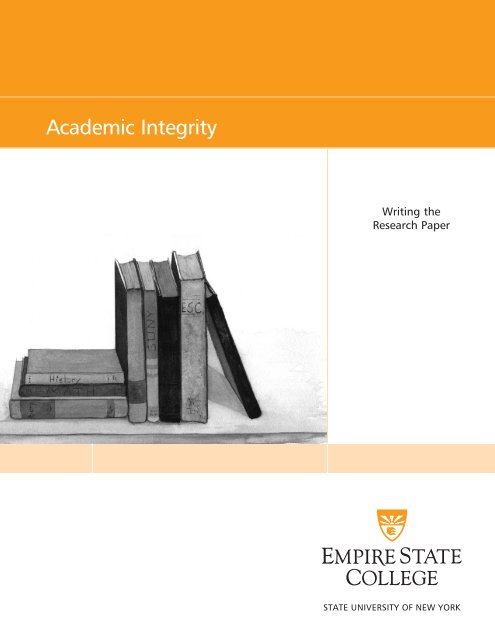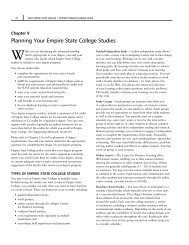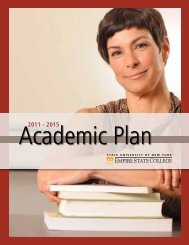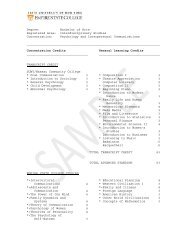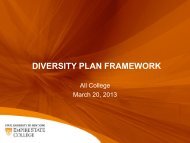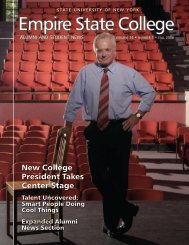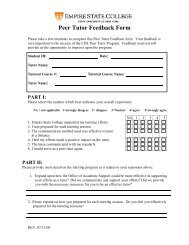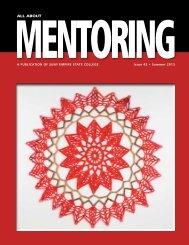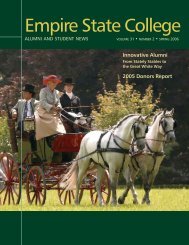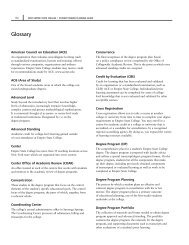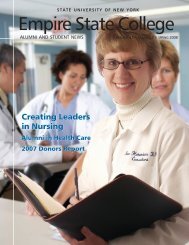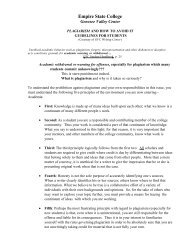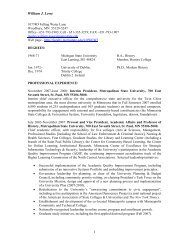Academic Integrity: Writing the Research Paper - SUNY Empire ...
Academic Integrity: Writing the Research Paper - SUNY Empire ...
Academic Integrity: Writing the Research Paper - SUNY Empire ...
- No tags were found...
Create successful ePaper yourself
Turn your PDF publications into a flip-book with our unique Google optimized e-Paper software.
EMPIRE STATE COLLEGE • ACADEMIC INTEGRITYP R O B L E M # 1 :BUT IT’S SUPPOSED TO BE A RESEARCH PAPER!You read all of <strong>the</strong> assigned chapters in <strong>the</strong> textbook. You researched a number of onlinedatabases, found and read additional articles on an issue presented in <strong>the</strong> textbook, inpreparation for writing your research paper. You now have all of this information “inyour head,” and you simply sit down and write <strong>the</strong> research paper using all of your newknowledge, making sure to put a “works cited” list at <strong>the</strong> end including all of <strong>the</strong> sourcesthat you read.Here’s a different scenario. You researched a number of online journal articles related toyour assigned paper topic. You cut and pasted many relevant portions of those articles intoyour paper, and you identified <strong>the</strong> sources within and at <strong>the</strong> end of <strong>the</strong> text.You get <strong>the</strong> paper back with comments that say, “This is not a research paper.” “What areyour own ideas?” “What are your sources?” and “Don’t plagiarize.” What went wrong?Remember that <strong>the</strong> emphasis in a research paper is on your own thoughts, shaped andvalidated by data from experts in <strong>the</strong> field. A college-level research paper is not just aseries of quotations strung toge<strong>the</strong>r, or a series of paragraphs cut and pasted from onlineresources, or a series of summaries of <strong>the</strong> different sources that you read (a series ofsummaries is called a review of literature in <strong>the</strong> field, in which you re-word informationto show that you understand it; it’s not a research paper). A college-level research paper isintended to show not only how well you can find and understand appropriate sources, butalso how well you can use and think about <strong>the</strong> information in those sources to make yourown informed judgments about a topic or an issue.Remember, too, that a reader needs to be able to distinguish your own ideas from yoursources’ ideas. A research paper cannot simply include a lot of information massed toge<strong>the</strong>rwithout accurately identifying where that information came from – you or one of yourmany expert sources. You need to identify specific information from your sources anddocument it, both within <strong>the</strong> paper and in a list of sources at <strong>the</strong> end.2
EMPIRE STATE COLLEGE • ACADEMIC INTEGRITYYou can translate this explanation into a process of approach to <strong>the</strong> research paperassignment, a process of approach that will help you maintain academic integrity:1 Complete your background reading, jotting down general information and your ownthoughts as you read.2 Ask yourself, “What do I think about my topic?”3 Create your <strong>the</strong>sis, main idea statement or research question which reflects your ownthinking and offers your own argument to prove.4 Do more directed, specific research to find expert sources to back up your ownargument. Be alert to evidence that does not support your position and address thatas well.• Read and take notes carefully, remembering <strong>the</strong>se two concepts:Identify, in your notes, whe<strong>the</strong>r you’ve quoted, summarized or paraphrased.Reproduce a quotation exactly as it appears in <strong>the</strong> original text.• Record <strong>the</strong> page numbers or o<strong>the</strong>r identifiers of your information (e.g., screennumber, title, author and/or publication date in an online source). You willneed identifiers when you document sources in <strong>the</strong> research paper. Theconventions of academic research writing require that you document a directquotation, a summary and a paraphrase – any information specific to thatsource – whe<strong>the</strong>r or not you quote that information directly or re-word itin a summary or paraphrase.5 Record additional source information needed in <strong>the</strong> list of sources at <strong>the</strong> end of <strong>the</strong>paper (author, title, publisher, place of publication, date of publication, span of pagesfor a journal article, Web address, date of access, etc.).6 Distinguish your own from o<strong>the</strong>rs’ information as you write <strong>the</strong> first draft of yourresearch paper. In <strong>the</strong> final draft, use a standard documentation format to identify <strong>the</strong>sources of information within <strong>the</strong> paper, in addition to listing those sources at <strong>the</strong> end.For more information on <strong>the</strong> processes of academic research and research writing, goto: www.esc.edu/Library. “<strong>Research</strong> How To’s” offer a multitude of research aids, from“Quick Tips for New Users” to a “Six-Step Approach to <strong>Research</strong>.” You can connectwith <strong>the</strong> college’s <strong>Writing</strong> Resource Center and click on <strong>the</strong> annotated resource lists for“<strong>Academic</strong> <strong>Writing</strong> Process” and “<strong>Research</strong> <strong>Writing</strong>.”3
EMPIRE STATE COLLEGE • ACADEMIC INTEGRITYP R O B L E M # 2 :I CITED MY SOURCES WHEN I PARAPHRASED AND SUMMARIZED; WHAT WENT WRONG?Just as it doesn’t show integrity to rely too much on o<strong>the</strong>rs’ ideas in a research paper, itdoesn’t show integrity to rely too much on o<strong>the</strong>rs’ words in a paraphrase or summary, bothof which ask you to rewrite o<strong>the</strong>rs’ ideas in your own language. Rewriting o<strong>the</strong>rs’ ideas inyour own language is an important skill for maintaining consistent style in a research paperthat integrates ideas from many sources. A paraphrase is a direct translation of <strong>the</strong> author’sideas into your own language. A summary is a condensed translation of only <strong>the</strong> author’smain ideas into your own language. Again, both seem simple. But in practice, you need tobe careful not to plagiarize inadvertently as you translate, as you can see from <strong>the</strong> followingsamples (taken from <strong>the</strong> <strong>Empire</strong> State College Undergraduate Catalog).QUOTATION:“Plagiarism, forgery, misrepresentation and o<strong>the</strong>r dishonest or deceptive acts constitute grounds foracademic warning or dismissal from <strong>the</strong> college. Mentors should first discuss suspected unethical actswith <strong>the</strong> student. Suspected cases should be brought to <strong>the</strong> attention of <strong>the</strong> center or program director ina timely way by a tutor, mentor, student, evaluator or o<strong>the</strong>r individual aware of <strong>the</strong> behavior. The centerdean or program director may discuss <strong>the</strong> case with <strong>the</strong> student, student’s mentor or o<strong>the</strong>r people deemedappropriate. The center dean or program director will refer cases requiring fur<strong>the</strong>r review to <strong>the</strong> centeror program academic review committee for consideration. A student has <strong>the</strong> right to present his or hercase in person to <strong>the</strong> center or program academic review committee. If warranted, a warning or dismissalwill be issued by <strong>the</strong> center dean or program director on <strong>the</strong> recommendation of <strong>the</strong> center or programacademic review committee. If a student disagrees with <strong>the</strong> decision of <strong>the</strong> center dean or programdirector, he or she may make a final appeal of <strong>the</strong> case to <strong>the</strong> college’s vice president for academic affairs.If a student is dismissed from <strong>the</strong> college, readmission is subject to <strong>the</strong> approval of <strong>the</strong> center dean orprogram director and may not occur sooner than three months after <strong>the</strong> dismissal is issued.”(<strong>Empire</strong> State College Undergraduate Catalog 69).(citation in MLA – Modern Language Association – format)PARAPHRASE THAT INADVERTENTLY PLAGIARIZES:(retains too much of <strong>the</strong> source’s language and sentence structure)The <strong>Empire</strong> State College Undergraduate Catalog (2005) states that <strong>the</strong> college has a policy that describes<strong>the</strong> different instances under which students may be withdrawn from <strong>the</strong> college. These instances includeplagiarism, forgery, misrepresentation and o<strong>the</strong>r instances that show dishonest or deceptive practice.(citation in APA – American Psychological Association – format)PARAPHRASE THAT RETAINS ACADEMIC INTEGRITY:According to a policy in <strong>the</strong> <strong>Empire</strong> State College Undergraduate Catalog (2005), <strong>the</strong> college may takepunitive action (including dismissal) against students who act fraudulently. Fraudulent action includes using<strong>the</strong> words or ideas of o<strong>the</strong>rs without proper attribution, falsifying documents, or depicting <strong>the</strong> work of o<strong>the</strong>rsas one’s own.(citation in APA – American Psychological Association – format)SUMMARY THAT RETAINS ACADEMIC INTEGRITY:The <strong>Empire</strong> State College Undergraduate Catalog (2005) states that <strong>the</strong> college may dismiss students whoin any way present o<strong>the</strong>rs’ work as <strong>the</strong>ir own (69).(citation in MLA – Modern Language Association – format)4
EMPIRE STATE COLLEGE • ACADEMIC INTEGRITYHow do you avoid inadvertent plagiarism? Write <strong>the</strong> paraphrase or summary in stages,a process that’s especially important when paraphrasing or summarizing a complexpassage. Do a direct translation of <strong>the</strong> author’s words first, a translation which probablywill retain <strong>the</strong> author’s sentence structure. Set this translation aside. Then do a secondstagetranslation to present <strong>the</strong> author’s ideas in your own way, making sure to make<strong>the</strong> wording and sentence structure your own. And always avoid plagiarism by citing<strong>the</strong> source.For more information and self-check exercises on paraphrase- and summary-writing,visit www.esc.edu/Library and link to <strong>the</strong> <strong>Writing</strong> Resource Center. In <strong>the</strong> search box,type in “summary.” There you will find <strong>the</strong> link to “<strong>Writing</strong> Summaries and Paraphrases”including an explanation and sample exercises.5
EMPIRE STATE COLLEGE • ACADEMIC INTEGRITYP R O B L E M # 3 :ISN’T IT ENOUGH TO MENTION MY SOURCES DURING AND AT THE END OF MYRESEARCH PAPER? WHAT DIFFERENCE DO DOCUMENTATION FORMATS –PARENTHESES AND PERIODS – MAKE?Using a documentation format is like speaking or writing grammatically. A documentationformat, like grammar conventions, provides a code that all speakers of a certain languageagree to follow in order to make communication easier. “Speakers of <strong>the</strong> language” inthis case are members of an academic community in a certain field of study. So while itis of primary importance to know when to document a source, it’s also very importantto know how.The problem is that <strong>the</strong>re are many different “hows,” depending on <strong>the</strong> field of study –too many to mention here. The two most well-known “hows” are formats of <strong>the</strong> ModernLanguage Association (MLA, used in <strong>the</strong> humanities) and American PsychologicalAssociation (APA, used in <strong>the</strong> social sciences). There are some general principles that both<strong>the</strong> MLA and APA formats use:1 Cite <strong>the</strong> source of a quotation within <strong>the</strong> paper by putting information in paren<strong>the</strong>ses:• <strong>the</strong> author’s last name and <strong>the</strong> page number in paren<strong>the</strong>ses at <strong>the</strong> end of <strong>the</strong>quotation (MLA), or• <strong>the</strong> date of publication and <strong>the</strong> page number in paren<strong>the</strong>ses at <strong>the</strong> end of <strong>the</strong>quotation (APA).Of course, <strong>the</strong> quotation itself needs to be reproduced exactly and needs to beginand end with quotation marks.2 Cite <strong>the</strong> source of a paraphrase or summary within <strong>the</strong> paper by mentioning <strong>the</strong>author at <strong>the</strong> start, so <strong>the</strong> reader can distinguish where your own ideas end and <strong>the</strong>source’s ideas begin. Put <strong>the</strong> page number in paren<strong>the</strong>ses at <strong>the</strong> end of <strong>the</strong> summary orparaphrase (MLA), or put <strong>the</strong> publication date in paren<strong>the</strong>ses after <strong>the</strong> mention of <strong>the</strong>author’s name (APA). The paraphrases and summary in problem #2 offer examples ofcitations using MLA and APA formats.3 At <strong>the</strong> end of <strong>the</strong> paper, alphabetically list <strong>the</strong> sources that you used, according toauthors’ last names. Only list those sources from which you quoted, paraphrased, orsummarized; do not include <strong>the</strong> sources that you read as background material butdidn’t use in <strong>the</strong> paper itself.6
EMPIRE STATE COLLEGE • ACADEMIC INTEGRITYConsult a standard style manual for more particulars about format. Note that <strong>the</strong>re areo<strong>the</strong>r formats as well, for example, those that use footnotes or endnotes instead of <strong>the</strong>MLA or APA in-text citations. Remember to ask beforehand which format to use, andalways consult your tutor if you have a question about using a standard format.Using a standard format is easy if you know which format to use and if you have a goodstyle resource to consult – you don’t have to memorize all of <strong>the</strong> periods and paren<strong>the</strong>ses.Simply find <strong>the</strong> appropriate example in <strong>the</strong> style manual (a journal article, a book with twoauthors, an online source, etc.) and replace <strong>the</strong> sample’s information with your source’sinformation, retaining <strong>the</strong> format.For more information on documentation formats, link to www.esc.edu/Library.Also connect to <strong>the</strong> <strong>Writing</strong> Resource Center, which has many links and self-checkexercises under <strong>the</strong> “Documenting Sources” link. The <strong>Empire</strong> State College Bookstore(www.esc.edu/Bookstore) stocks A Writer’s Reference, by Diana Hacker, which includesexplanations of many documentation styles.7
EMPIRE STATE COLLEGE • ACADEMIC INTEGRITYP R O B L E M # 4 :BUT I THOUGHT IT WAS GOOD PRACTICE TO GET SOME OUTSIDE HELP!It is. It’s important for you, as a writer, to get a reader's reaction. (Is <strong>the</strong>re enoughinformation here? Is <strong>the</strong> second paragraph clear?) And it’s important for you, as a student,to consult your tutor if you have general questions about course concepts or particularquestions about <strong>the</strong> writing assignment. But it’s also important to stop <strong>the</strong>re. Both coursetutors and casual readers can help you understand and clarify your own ideas; <strong>the</strong>y shouldnot create those ideas for you. If a helper does create ideas, and if you use those ideasand that language as your own, you will not be acting with integrity. Passing off ideas orlanguage created by o<strong>the</strong>rs, without documenting <strong>the</strong> source, is a form of plagiarism. Evenwhen you work collaboratively with o<strong>the</strong>r students, you need to identify and give credit tospecific ideas that are not your own. It’s important for all assignments to reflect your ownthinking, understanding, and form of expression.If you’re uncertain about plagiarism – what it is, and how it happens – go to <strong>the</strong> <strong>Empire</strong>State College library at www.esc.edu/Library. Under <strong>the</strong> heading “Get Started,” youwill find “More Help.” From <strong>the</strong>re you can access “<strong>Academic</strong> <strong>Integrity</strong> and AvoidingPlagiarism” and quiz your understanding of academic integrity, read about recognizingand avoiding plagiarism, and more.THERE ARE MANY SOURCES AVAILABLE TO HELP YOU APPROACH YOURACADEMIC WORK WITH INTEGRITY. THE MAIN THING TO REMEMBER IS THAT YOUALWAYS NEED TO CREATE YOUR OWN IDEAS AND THEN ACKNOWLEDGE OTHER SOURCES’IDEAS THAT YOU USE TO SUPPORT YOUR OWN.8
06149F-047–Rev. 7/2009www.esc.edu


